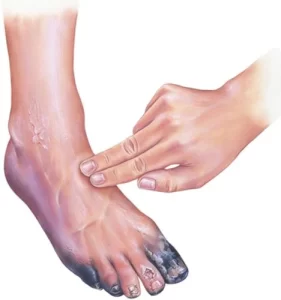
What is Gangrene?
Gangrene is a serious medical condition that occurs when a significant loss of blood supply leads to tissue death. This can happen in any part of the body but is most common in the extremities such as toes, fingers, feet, and hands. Gangrene is potentially life-threatening and requires prompt medical attention.
Who is at Risk for Gangrene?
Certain individuals are at higher risk of developing gangrene, including those with chronic conditions such as diabetes, peripheral artery disease (PAD), and immune system disorders. Smokers, individuals with severe injuries or frostbite, and those undergoing chemotherapy are also more susceptible to this condition. Reduced blood flow and weakened immunity are significant risk factors that can make one more prone to gangrene.
Symptoms and Causes
Gangrene may present with symptoms such as severe pain followed by numbness, skin discoloration (ranging from red to black), foul-smelling discharge from a wound, and a noticeable change in the skin’s texture, which may appear shiny or thin. The most common causes include infections, traumatic injuries, and conditions that affect blood circulation, such as diabetes and PAD.
Diagnosis and Tests
Early diagnosis is critical in managing gangrene effectively. If gangrene is suspected, a healthcare provider will likely conduct a physical examination and order diagnostic tests such as blood tests, imaging studies (like X-rays or MRIs), and tissue cultures. These tests help determine the extent of tissue damage and the presence of any infections.
Management and Treatment
Treatment of gangrene depends on its type and severity. Immediate steps typically include the use of antibiotics to combat infection and surgery to remove dead tissue. In severe cases, amputation of the affected limb may be necessary to prevent the spread of infection. Hyperbaric oxygen therapy, which involves breathing pure oxygen in a pressurized room, is another treatment that can help stimulate healing in some types of gangrene.
Prevention
Preventing gangrene, especially for at-risk individuals, involves maintaining good overall health and managing underlying conditions. Regular monitoring of blood sugar levels for diabetics, quitting smoking, keeping wounds clean and dry, and seeking prompt medical attention for any signs of infection are crucial preventive measures. Ensuring proper foot care, particularly for those with diabetes or circulation issues, is also essential in preventing gangrene.
Outlook / Prognosis
The prognosis for gangrene depends largely on how quickly it is diagnosed and treated. With early intervention, the outcomes are generally better. However, if left untreated, gangrene can lead to serious complications, including amputation and life-threatening infections.
If you or a loved one are at risk for gangrene or experiencing symptoms, contact Southwest Foot and Ankle Center today. Our specialized team can provide expert care and guidance to help prevent and manage this serious condition. Don’t wait — reach out to us for the care you need!
Contact us
Schedule an appointment
with our specialists by contacting us or calling our:
